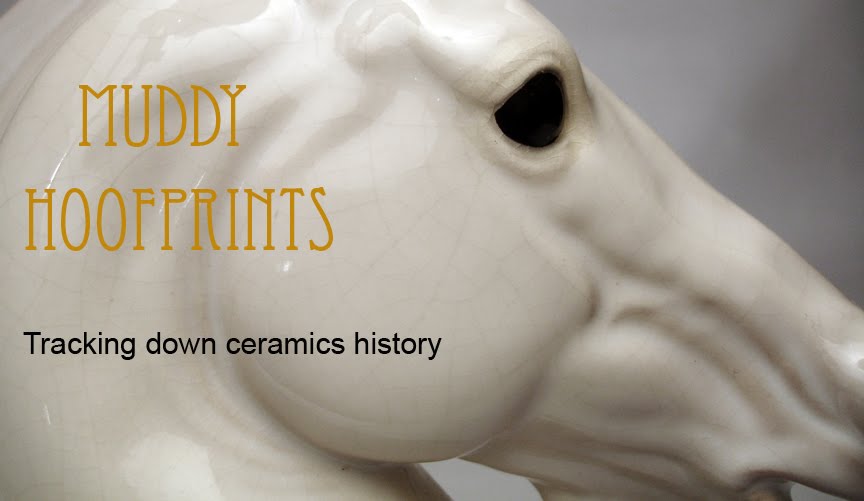Oddly, necessities of moldmaking first steered me in this direction, that eventually led to sculpture improvement. It would be helpful if this occurred more frequently, but that would make my job easier. We certainly can't have that. Another factor, the choice to offer two breed versions of this stock horse, clinched the decision which led to better results. Usually, the opposite is the case, because a sculptor can generalize too much! There has been a trend, nay, a tradition, among model horse exhibitors (and producers) to use one mold for multiple breed designations. For some molds, this works fine, as some breeds have the same foundations. In other cases, it doesn't work. The more I researched for the the two versions of this horse, the more it became clear that one head was not going to work for two breeds. The client desired the changes in grooming and overall hair volume between the two versions. We agreed that to better capture each individual breed, it had to go beyond the hair-do. We also agreed that the second head, the one he was wearing at the end of this blog post, didn't fit and seemed too general.
Under the client's direction, I sculpted a third head, before their very eyes. The Mustang head is on the right. A little later, the Applaoosa head on the left was sculpted. The coarseness of the Mustang really stands out when side-by-side with the pedigree Appaloosa. They are shown here in the original Chavant clay.

We're both much happier with this solution. The previous Mustang heads look stylized, like "artist's conceptions", compared to these revisions. Remember?

The new Mustang head could have some draft in the woodpile, and he sports a beard and fully-fuzzed ears (sculpted separately).
Where did I get my idea of an Appaloosa head? My client searched the web for photos of Appaloosas of the 1960's and earlier. I pulled two books from my shelves, Appaloosa (1972) and Champion Horses of the Americas (1971). Like a Mustang, there was a range of overall face types, with a few features in common. The eye, shaped like an almond, seemed to show up the most frequently. Just one photograph, of "High Thunderbird", looked strikingly like Carol Williams' QH-1 (the Stone QH mold) in the head and large, round eye. Another old Appy looked like a spotted Thoroughbred (and was, virtually, by descent). I certainly don't want to get too close to what others have done before, so I chose to go with the alternate, the look I saw most frequently among those '60's Apps. This Appalooosa head is refined without being overly wedged or Arab-y; it has the eye shape I saw on so many of the old photographs. Very different, but both new heads have stock horse substance, honesty, work ethic.
Then, it was time to recapitate him. My husband molded the heads and their respective ear sets (fuzzy and clean-shaven), and poured resin castings for me to work with. I played with the ear positioning on the Appy head, after attaching it to the body. Somehow, it needed to be less like the designated position for the Mustang, and more like the Appies in the old photos. Forward, pointing slightly outwards, not airplaning, but not with the tips touching, either. Pleased with the progress, I went to bed.

The next morning, I walked in, looked at his head set, and immediately decapitated him a third time. I mean, I didn't even sit down yet. Wrong wrong wrong. Let's try that again. Much better. Oh, and I was curious to see if my Cowgirl Poetry (classic scale) custom tack set would fit him. I couldn't find my matching saddle pad, and looks like I need a new girth to slide that saddle back.

Then, it was ON. I was sending pix before even completing mane sections! The client asked for a rattier tail than previously sculpted, and since it no longer needed to be a plug for the pourhole, I was free to reduce it and get really ratty. Next, the client wanted a sparse, flipping-on-both-sides mane. Even though the old show photos had completely roached (or with just a tuft of forelock) manes, the client wanted that little bit of outline break-up, that "umph" of a sparse App mane.

The tail needed another edit, because it STILL had too much hair. I kept going back to the photos, which showed shaved or very short hairs on the upper tail, which fanned out farther down into sparse, longer hair. Underneath, his tail bone is visible.

Have I toyed with you enough? Here is my rat-tail Appaloosa, as he stands tonight. The few tasks yet to be done may not even be noticeable in later photos (a tail key, a signature, etc.), so these are a fair representation of the final Appaloosa sculpt. The Mustang will follow, of course.


Many more photos, brighter images, will be in galleries at my yahoogroup and Facebook art page.
I hope this sculpt serves a niche that was not well addressed in the hobby. There are so few specific Appaloosa resin molds, and I can count the existing Appaloosa ceramic molds on one hand (one is the same as a resin). It's a shame there are so few, because so many artists love painting and glazing Appaloosas! This guy, my little "ratrod", was made for exhibitors and collectors who dearly love the differences in breed morphology.










